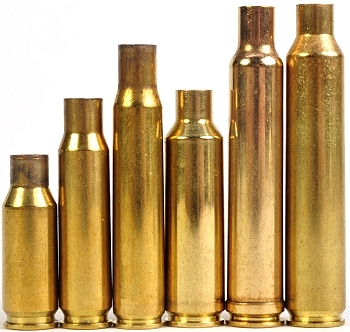 There are lots of ways to kill deer, hogs, and black bear with a 30 caliber rifle, beginning with the 30 Remington AR, far left. The 308 Winchester, next, has been used in many applications; sporting, military and civilian security. Hunters in Maine drop moose with them on a regular basis. Moving right, the 30-06 Springfield is the grandfather of the all purpose cartridges, and it does so convincingly.
There are lots of ways to kill deer, hogs, and black bear with a 30 caliber rifle, beginning with the 30 Remington AR, far left. The 308 Winchester, next, has been used in many applications; sporting, military and civilian security. Hunters in Maine drop moose with them on a regular basis. Moving right, the 30-06 Springfield is the grandfather of the all purpose cartridges, and it does so convincingly.
Before moving further right, a thought on power requirements and some conflicting opinions on what it takes to drop larger North American game – a passage from Alaska’s Department of Fish & Game hunter education information, “If you are going to hunt brown bear on the Alaska Peninsula or Kodiak Island, a .30-06 loaded with 200- or 220-grain Nosler® or similar premium bullet will do the job with good shot placement. Only consider using a .300, .338 or larger magnum if you can shoot it as well as you can the .30-06.” I am not sure which issue of Guns & Conjecture moved perception to nothing less than a 375 H&H for hunting brown bear, but I believe that is how this quantum leap in cartridge power requirements came about.
Virtual hunters prefer heavy magnums… but most real hunters don’t
The Internet is a wonderful place for people who have never held much more than a keyboard to troll message boards and then give expert hunting and firearm advice. It takes a lot to be an expert when it comes to hunting. More than an expensive guided trip or two, or a trip down the road to bag a local buck, it takes years of empirical data collection, hunting lots of game under lots of conditions, then arriving at conclusions dispassionately. I’m not an expert at anything… especially hunting, even though I have successfully hunted a good deal over the years. All I know is that if I place a shot correctly, which should always be the objective, I can drop most game with much smaller cartridges than most would want to consider and without overreaching the round’s capability.
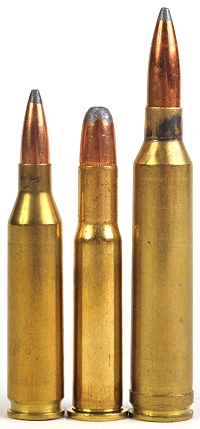
Left – My personal North American arsenal; 243 Winchester, 30-30 WCF and 7mm Remington Magnum. It isn’t like I don’t have lots of other firearms that chamber lots of other cartridges. I do and I love to shoot, handload and hunt with them on occasion. Still, when I am not researching, writing or otherwise trying to entertain myself with interesting gadgetry, these are the rounds that have killed most of what I have hunted. Old cartridges, seasoned firearms that kill effectively.
Don’t scoff, big bear were dropped by early settlers and Alaskan wilderness trappers and explorers with not much more than a musket. Eskimo one-gun hunters made do with lighter firearm that had to kill small game and large predators. Elephant were routinely killed by small bore, high velocity 7mm cartridges. I am not recommending, I’m just saying that the need for a 375 H&H as a minimum to drop a big bear is a little bit much.
I like Boddington as an author. He always poses next to whatever it is he shot as proof of achievement, he has hunted a lot, all over the world and with great frequency. In his book, American Hunting Rifles, he includes a survey of Alaskan professional hunters and their clients as well as professional hunter recommendations for clients. In regard to large bear, the .300 and 338 belted Winchester Magnums loomed large, but the 30-06 Springfield also got half the votes and the 7mm Remington Magnum was popular up through large grizzly, but not so much for brown bear. We like to be over-gunned because it makes the game we hunt seem proportionally more dangerous.
Does any of this have any bearing on the topic at hand?
 There is an exercise in flying a plane where you fly in tight circles and attempt to maintain constant altitude. When you get it right, the plane flies into its own prop wash and you get a bit of turbulence. This is me, flying around in tight circles, in search of prop wash. Reviewing factory ammo and handload data ballistics regarding 300 WSM potential was interesting. With barrel lengths equal, the 81 grain capacity case 300 WSM seemed to consistently best the 86 grain capacity case 300 H&H. The 300 WSM swapped leads with the belted 300 Winchester Magnum, dependent on the reloading manual and barrel length, then it gave up ground to the 99 grain capacity case 300 Weatherby and other cartridges with similar or greater capacity. The Sierra manual shows the 300 WSM with a 24″ barrel categorically besting the 300 H&H with a 26″ barrel, yet load data for the 300 WSM was truncated at 200 grains of bullet weight, while the 300 H&H and other 300 magnums went on to 220 grains. In fact, even the modest 30-06 Springfield routinely listed load data with bullet weights through 220 grains traveling at a snail like 2,500 fps.
There is an exercise in flying a plane where you fly in tight circles and attempt to maintain constant altitude. When you get it right, the plane flies into its own prop wash and you get a bit of turbulence. This is me, flying around in tight circles, in search of prop wash. Reviewing factory ammo and handload data ballistics regarding 300 WSM potential was interesting. With barrel lengths equal, the 81 grain capacity case 300 WSM seemed to consistently best the 86 grain capacity case 300 H&H. The 300 WSM swapped leads with the belted 300 Winchester Magnum, dependent on the reloading manual and barrel length, then it gave up ground to the 99 grain capacity case 300 Weatherby and other cartridges with similar or greater capacity. The Sierra manual shows the 300 WSM with a 24″ barrel categorically besting the 300 H&H with a 26″ barrel, yet load data for the 300 WSM was truncated at 200 grains of bullet weight, while the 300 H&H and other 300 magnums went on to 220 grains. In fact, even the modest 30-06 Springfield routinely listed load data with bullet weights through 220 grains traveling at a snail like 2,500 fps.
I theorized that the cut off on bullet weight had to do with limited case capacity and heavy bullets protruding into cases. Loaded ammo seems to stop at 180 grains for the 300 WSM, but then Nosler’s reloading manual stepped up with 220 grain loads nearing 2800 fps, as did Hornady, even at 150 fps slower through a 2″ shorter 24″ barrel. Then I thought, maybe bullet weight, within reason, isn’t as important as it once was… when bullets were made out of wood, primers were corrosive and people believed there were brush cartridges firing bullets that weren’t deflected by brush. Maybe the yield on bullet technology was light heavyweight hitters that were not round nosed, but tough and with lots of controlled expansion. So I decided to defer to Winchester, the folks who designed the cartridge, and looked up the recommended applications for 300 WSM ammunition; American buffalo, Alaskan moose and brown bear and even African leopard. Bear and moose carried a recommended 180 grain bullet weight, the other 150 and 180 grain bullet weights. Not a 200 grain slug in sight. Amazingly enough, the same bullet weights Winchester offered as loaded ammo when the round was introduced.
And now for the prop wash…
If the 30-06 Springfield is highly regarded by the State of Alaska’s Department of Fish and Game for hunting brown bear, and if nearly half of the professional hunter respondents to the state brown bear survey recommended the 30-06 Springfield to their clients, since the 300 WSM has 150 fps to – 200 fps velocity edge over the 30-06 Springfield, I would deduce that the 300 WSM can be used effectively on any big and dangerous game to be found in North America, with the proper bullet. The following represent my choices for the 300 WSM and are included in our 300 WSM handload data.
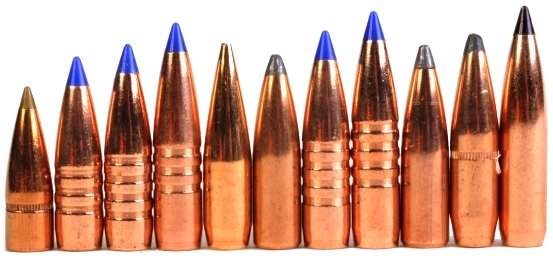 .
.
|
Bullet |
Mfg # | Weight Grains |
*Length Inches |
COL Inches |
Case Capacity After Seating |
| Remington AccuTip** |
– |
125 | 1.025 | 2.810 | 75.6 |
| Barnes MRX | 30882 | 150 | 1.209 | 2.830 | 72.7 |
| Barnes MRX | 30885 | 165 | 1.285 | 2.830 | 71.3 |
| Barnes TTSX | 30878 | 168 | 1.413 | 2.830 | 68.9 |
| Berger VLD Hunting | 30512 | 175 | 1.287 | 2.860 | 72.0 |
| Sierra Pro Hunter | 2150 | 180 | 1.205 | 2.800 | 72.0 |
| Barnes MRX | 30888 | 180 | 1.360 | 2.850 | 70.2 |
| Barnes TTSX | 30879 | 180 | 1.480 | 2.860 | 68.1 |
| Nosler Partition | 16331 | 180 | 1.265 | 2.835 | 71.5 |
| Hornady Interlock | 3085 | 190 | 1.335 | 2.830 | 70.8 |
| Nosler AccuBond | 54618 | 200 | 1.504 | 2.860 | 67.2 |
|
* As Measured **30 Remington AR pulls |
|||||
Barnes is a good news/compromise news scenario when it comes to the 300 WSM. Tough bullets, reliable expanders and very accurate, however, those made of solid low density copper tend to be comparatively long for their weight. The extra length reduces net case capacity and sometimes taxes rifling twist rates. MRX bullets are an improvement. Their Silvex® core approaches lead in density, which results in shorter for weight bullets than the TTSX and long range stability, while retaining 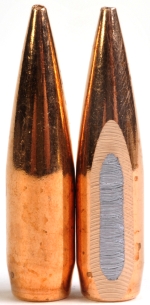 down range reliable expansion. Contrary to what you may have read, MRX bullets are not filled with a cylinder of tungsten. Silvex is an alloy that contains tungsten, tin and bismuth and approaches the density and weight of lead which is 0.410 lb/cu.in. while tungsten is approximately 50% heavier at 0.697 lb/cu.in. Still, the result is that Barnes MRX bullets come closer to lead jacked bullet in length and the short length improves stability.
down range reliable expansion. Contrary to what you may have read, MRX bullets are not filled with a cylinder of tungsten. Silvex is an alloy that contains tungsten, tin and bismuth and approaches the density and weight of lead which is 0.410 lb/cu.in. while tungsten is approximately 50% heavier at 0.697 lb/cu.in. Still, the result is that Barnes MRX bullets come closer to lead jacked bullet in length and the short length improves stability.
So why not just go MRX on Barnes and get the best of both worlds? TTSX 180 grain 30 caliber bullets cost approximately 76 cents per, while the MRX is $1.57 per bullet. But then the MRX bullets are packaged in individual stations, twenty to the box, which brings true decadence to handloading. The primary difference between 150 grain – 165 grain range and 180 grain Barnes bullet is suitability for larger game, specifically elk and Alaskan moose.
The Berger Bullet Buck Buster pictured, left (no, not its real name, but say that three times fast) is a great blend of low drag and lead filling. The combination makes for high retained velocity and all associated ballistic indicators. At 175 grains, at least a light heavyweight, it is a serious, controlled expansion, big game projectile that takes away little case capacity and it performs with excellent accuracy. The Sierra 180 classic, bonded, single lead core bullet expands a bit more quickly, doesn’t have the Berger’s BC, but also happens to be accurate.
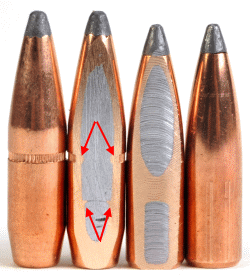 The Nosler Partition, far right pair, is my favorite deep penetrating, controlled expansion bullet. If I were going to hunt something large and potentially dangerous with the 300 WSM, this bullet would be on the top of my list. With lots of data collected from hunting and ballistics testing, the Partition works across a wide range of calibers and it does so consistently. It has a two piece jacket, one in front to expand in a controlled fashion and one in the rear of the “H” compartment that keeps the bullet driving through, regardless what happens to the bullet’s nose. A substitute might be the Swift A Frame in similar weights.
The Nosler Partition, far right pair, is my favorite deep penetrating, controlled expansion bullet. If I were going to hunt something large and potentially dangerous with the 300 WSM, this bullet would be on the top of my list. With lots of data collected from hunting and ballistics testing, the Partition works across a wide range of calibers and it does so consistently. It has a two piece jacket, one in front to expand in a controlled fashion and one in the rear of the “H” compartment that keeps the bullet driving through, regardless what happens to the bullet’s nose. A substitute might be the Swift A Frame in similar weights.
The 190 grain Hornady is built along the lines of the Sierra 180 grain, a bit tougher jacket and with locking rings in the jacket, indicated, that anchor the lead core to reduce separation is intended to hold core and jacket together. Good utility bullet. The Nosler AccuBond is noted as the heavyweight, not pictured, but I don’t believe its one piece core construction is a sturdy as the Partition and, perhaps, is more suitable for thin skinned, heavy body game. Overall, lead and other heavy core rules with optimal performance coming from the shortest bullets, leaving the greatest case capacity.
Return to the better old days…
Not too long ago we put together load sheets for each project with more complete and organized data. More recently we experimented with embedding handload data within the associated article. Unfortunately, by doing so, multiple coverage of a cartridge scattered data and made it more difficult to locate even with the article search function. So we are returning to the dedicated load sheet approach beginning with this project. 300 Winchester Short Magnum handload data.
A North American one gun, big game solution?
Breaking away from the 300 WSM performance issue for a moment, I just wanted to comment on the Remington Model 700 SPS rifle for a moment. This is an under $600 rifle that has all of the strength, geometry and ballistic performance of Remington rifles that sell for twice the price. In exchange for the low price there is an absence of frills: jeweled bolt, satin or bright blue and walnut or integral frame composite fiber stock. Still, the SPS is a good looking gun and a tough, durable hunting rifle.

A matte finish works for me as I’ve stopped shaving in the reflection of my rifle and there is no pretty walnut to moan and groan about after dragging the gun around in the woods all day. The six pounds and change weight is a big plus also. Scope mounting is straight forward, especially with Warnes bases and rings, and there is plenty of clearance with medium height mounts to clear a 44mm objective lens. Recoil and report is… brisk. Hey! It’s a magnum. The Remington recoil pad and synthetic stock absorb the greatest part of the hit, putting this into the heavy 30-06 Springfield load class in the category of shooter’s comfort. This combination definitely makes the single gun for North American Hunting list.
Remington’s Model 700 SPS Magnum Part I
Remington’s Model 700 SPS Magnum Part II

Email Notification